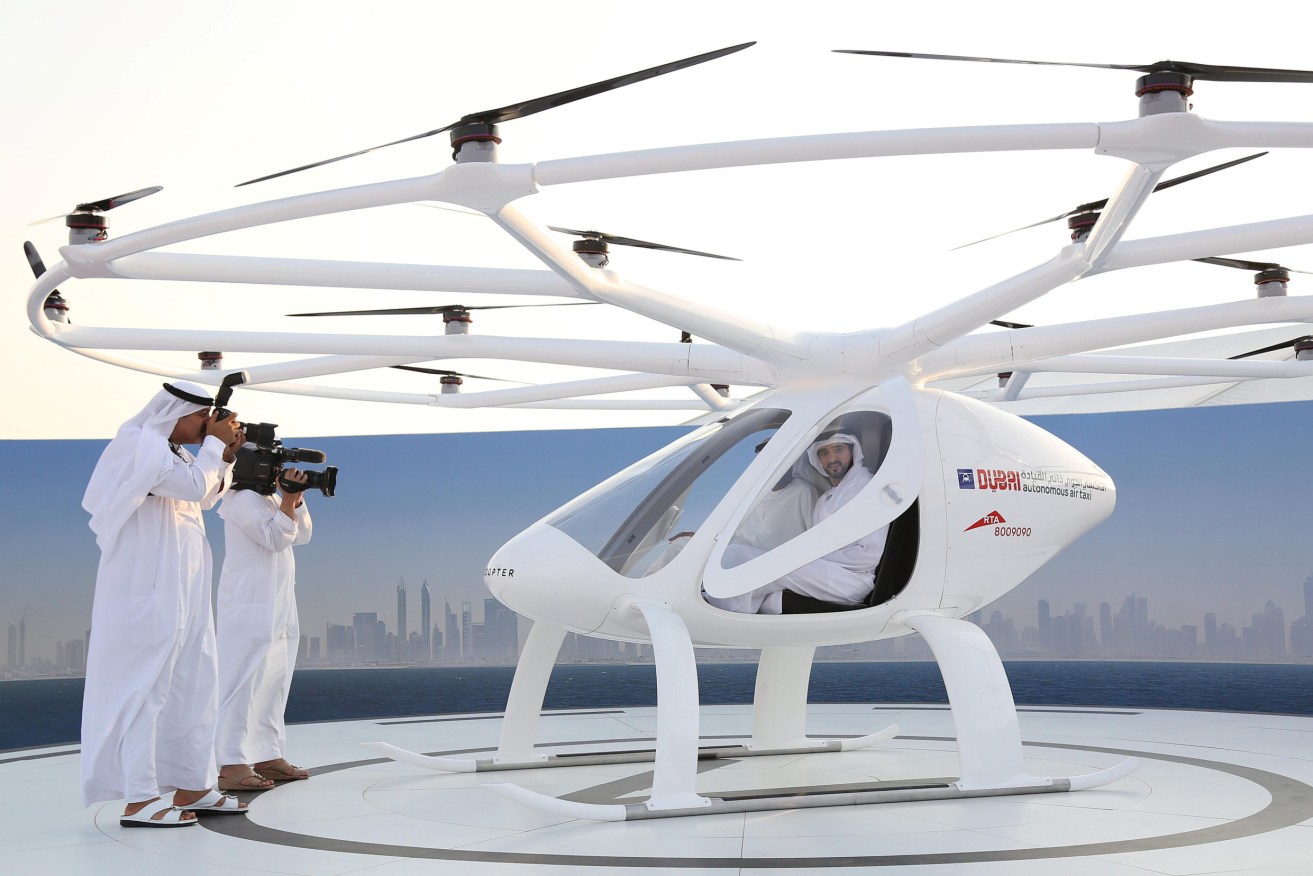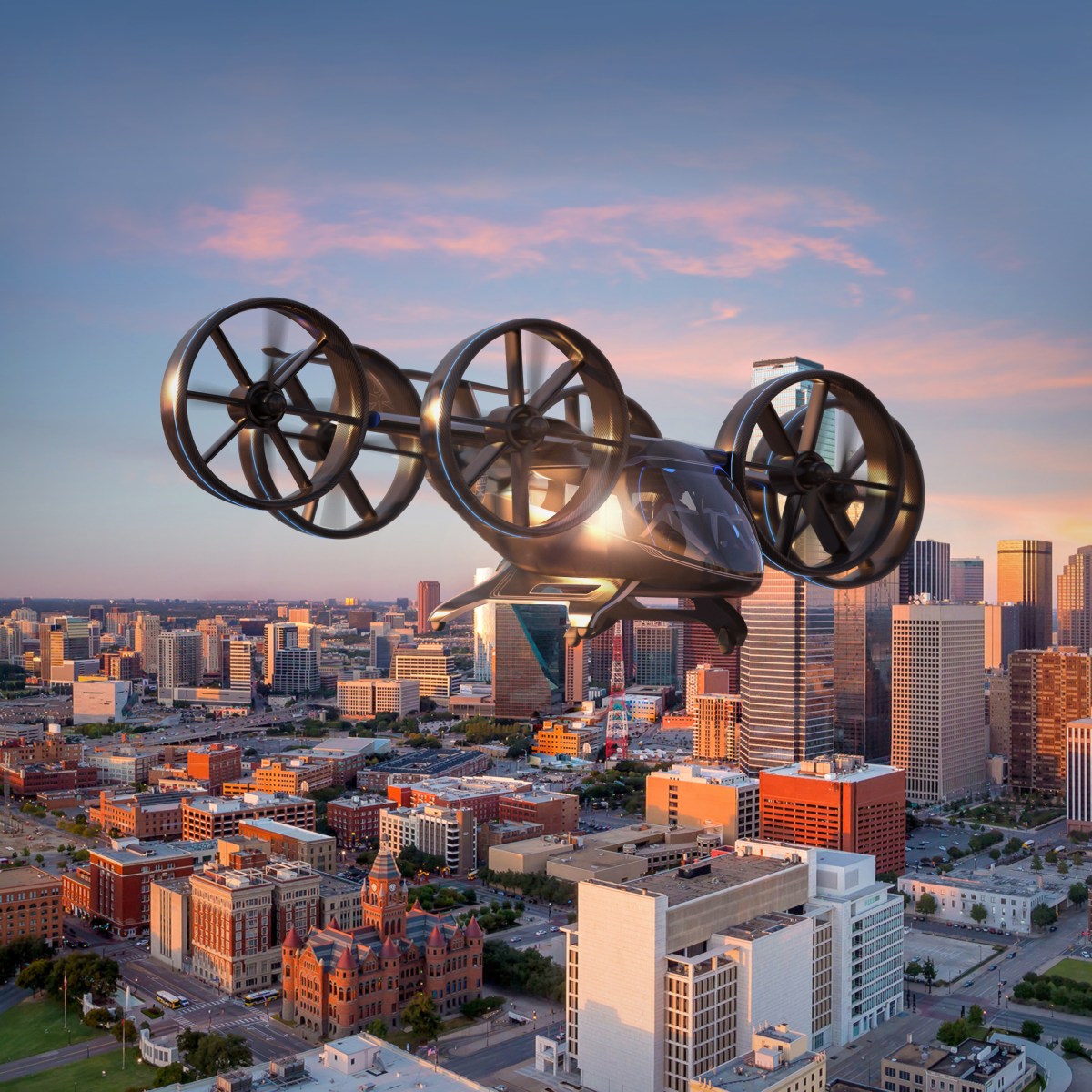A flying start on future transport options
Air taxis could revolutionise transport and help revitalise SA regions, writes Mirjam Wiedemann.

Dubai's Crown Prince with a German-built flying taxi drone in 2017. Photo: Reuters/Satish Kumar
Challenges of climate change, remoteness of regional Australia and a pandemic highlight the need for innovative, new regional transport options for South Australia.
Air taxis (flying drones for up to seven passengers) could be a viable solution to connect residents of rural and remote South Australia with Adelaide and bring more tourists to the regions. Flying air taxis or electric vertical take-off and landing vehicles (eVOTLs) are expected to be environmentally friendly, easy to integrate in existing infrastructure and will connect regional South Australians even when ground infrastructure is disrupted because of weather or natural disasters.
As a city-centred state, South Australia could benefit from a flying taxi service that makes the commute between regional and rural South Australia and Adelaide convenient, safe, and green. As recently reported by InDaily, the population of the Adelaide metropolitan area is growing while regional and rural South Australia are missing out. A flying air taxi service provided by electric vertical take-off and landing vehicles could not only revitalise the regions through population growth but also bring much needed tourists to the regions.
Flying drones have been used for goods delivery for a few years now in different parts of the world. Research has been ongoing in developing flying drones into passenger transport options. Numerous vehicles have been developed from start-ups but also from established aeronautical companies such as Airbus and Boeing. While research and development are ongoing, propulsion technology ranges from traditional fossil fuel powered engines to hybrid, or fully electric, and there are also considerations of future hydrogen powered vehicles.
For a long time, one of the biggest challenges was a short range of electric vehicles. Current technology has now reached suitable ranges of more than 800 km. For vehicles of up to seven passengers, costs could be as cheap as 0.88$ per km. For example, a flight from Adelaide’s CBD to Port Lincoln could become feasible in less than 30 minutes and as cheap as $30 per passenger.
While technology and feasibility are still in its infancy in Australia, research in Europe and the United States has been ongoing for numerous years. Test flights have been conducted in several locations globally, including in Dubai and Singapore.
With the fast advancement of technology and knowledge worldwide, South Australia could run a flying air taxi service as early as 2022, although a timeline of 2024-2025 seems more realistic considering several challenges. Australia is currently developing a policy for advanced air mobility and Airservices Australia has partnered with EmbraerX (another possible vehicle provider) to develop urban air traffic management solutions.
Other obstacles such as noise and user acceptance are becoming less of a challenge with evolving technology dramatically decreasing the noise of flying drones. Recent surveys in the Unites States and Europe have shown that people are in favour of using eVTOLs for flying to events such as concerts and even would be happy to use them for their daily commute.
Using eVTOLs for a daily commute or for meetings and appointments in Adelaide could be a real win for South Australia’s regions. Offering people, the opportunity to live in our beautiful regions (especially during or post a pandemic) but having an affordable, green and reliable transport option to show up in their CBD offices from time-to-time, meeting clients, enjoying Adelaide’s nightlife or coming for medical treatment could be the integrative regional transport solution people were looking for.

The Bell Nexus hybrid-electric air taxi unveiled in 2019. Rideshare company Uber has expressed interest. Image: Bell/Cover Images
While vehicle technology has progressed rapidly in recent years, researchers agree that other areas of the eVTOL ecosystem need more investigation. EVTOLs use so called vertiports for take-off and landing and recharging. Questions of location and station capacities need to be determined for every geographic region that adapts eVTOLs as transport option.
Sustainable pricing strategy and questions of the business model need to be explored. Developing an efficient routing system to minimise customer waiting time, vehicle idle time and travel costs is required, along with a vehicle maintenance structure. Until every person has replaced their car with a flying vehicle (it may sound like science fiction but could become a reality from 2050 onwards) ground and air transportation needs to be carefully integrated.
Flying taxis offer point-to-point connectivity and therefore regional integration is crucial. Considering intermodality and eVTOLs as part of a transport systems will be one part of a successful puzzle to a more integrative infrastructure solution for South Australia and better connectivity for regional and rural communities.
Furthermore, while the air taxis are already out there, they could also become part of the supply chain for goods. A hybrid system of passenger transport and last-mile delivery of goods is an opportunity not to be missed. Small medical devices, medicines or even the latest fashion articles could be delivered in very short timeframes from the CBD to nearly any community in South Australia. Predicting the demand for air taxis depending on location, day of the week, time of the week and time of the year is another challenge that needs to be added to the list.
Addressing those questions will keep researchers, industry partners and Government busy for the foreseeable future until it is time for take-off. Will you be on board?
Dr Mirjam Wiedemann is Lecturer and Researcher in Aviation at UniSA.




